2016 NISSAN FRONTIER manual transmission
[x] Cancel search: manual transmissionPage 453 of 469
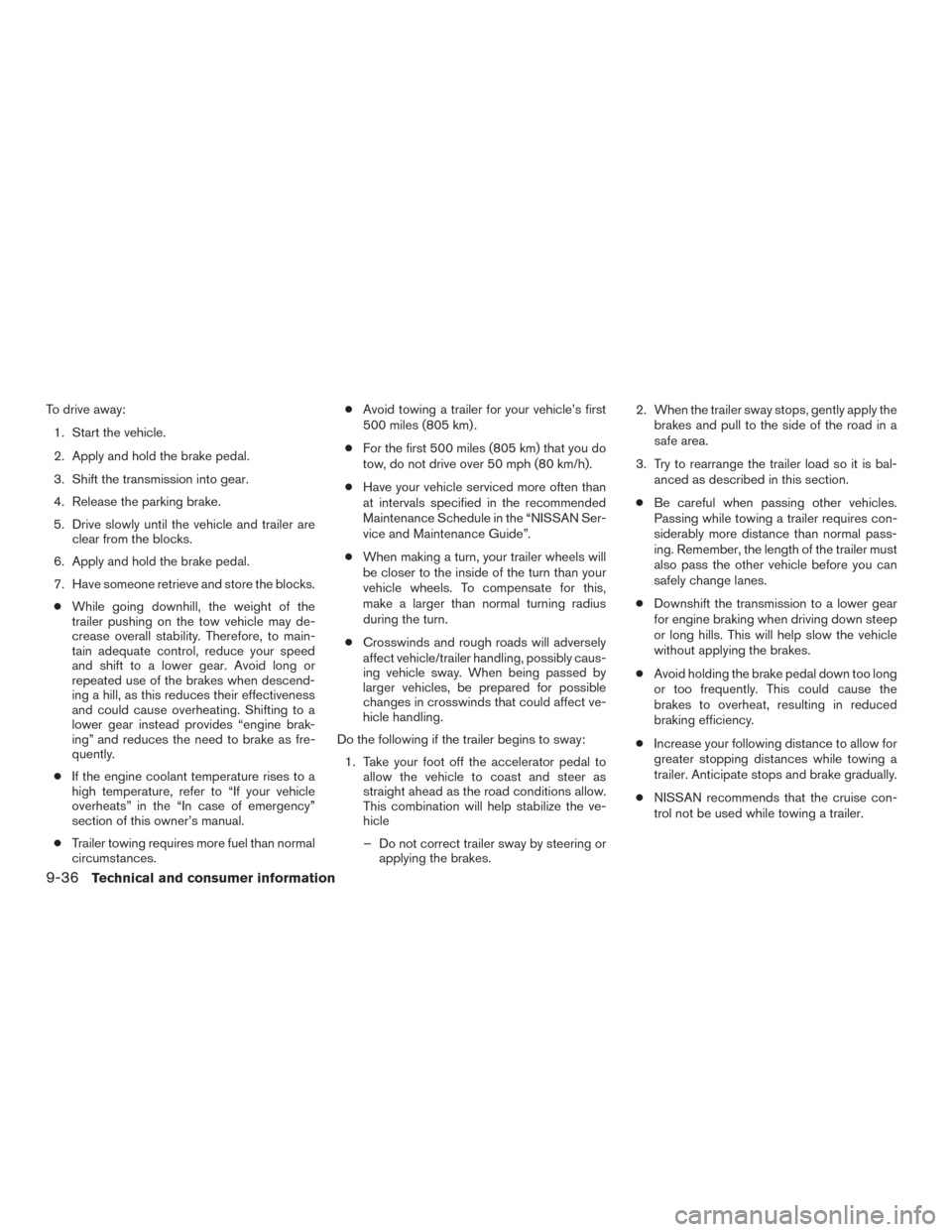
To drive away:1. Start the vehicle.
2. Apply and hold the brake pedal.
3. Shift the transmission into gear.
4. Release the parking brake.
5. Drive slowly until the vehicle and trailer are clear from the blocks.
6. Apply and hold the brake pedal.
7. Have someone retrieve and store the blocks. ● While going downhill, the weight of the
trailer pushing on the tow vehicle may de-
crease overall stability. Therefore, to main-
tain adequate control, reduce your speed
and shift to a lower gear. Avoid long or
repeated use of the brakes when descend-
ing a hill, as this reduces their effectiveness
and could cause overheating. Shifting to a
lower gear instead provides “engine brak-
ing” and reduces the need to brake as fre-
quently.
● If the engine coolant temperature rises to a
high temperature, refer to “If your vehicle
overheats” in the “In case of emergency”
section of this owner’s manual.
● Trailer towing requires more fuel than normal
circumstances. ●
Avoid towing a trailer for your vehicle’s first
500 miles (805 km) .
● For the first 500 miles (805 km) that you do
tow, do not drive over 50 mph (80 km/h).
● Have your vehicle serviced more often than
at intervals specified in the recommended
Maintenance Schedule in the “NISSAN Ser-
vice and Maintenance Guide”.
● When making a turn, your trailer wheels will
be closer to the inside of the turn than your
vehicle wheels. To compensate for this,
make a larger than normal turning radius
during the turn.
● Crosswinds and rough roads will adversely
affect vehicle/trailer handling, possibly caus-
ing vehicle sway. When being passed by
larger vehicles, be prepared for possible
changes in crosswinds that could affect ve-
hicle handling.
Do the following if the trailer begins to sway: 1. Take your foot off the accelerator pedal to allow the vehicle to coast and steer as
straight ahead as the road conditions allow.
This combination will help stabilize the ve-
hicle
– Do not correct trailer sway by steering or applying the brakes. 2. When the trailer sway stops, gently apply the
brakes and pull to the side of the road in a
safe area.
3. Try to rearrange the trailer load so it is bal- anced as described in this section.
● Be careful when passing other vehicles.
Passing while towing a trailer requires con-
siderably more distance than normal pass-
ing. Remember, the length of the trailer must
also pass the other vehicle before you can
safely change lanes.
● Downshift the transmission to a lower gear
for engine braking when driving down steep
or long hills. This will help slow the vehicle
without applying the brakes.
● Avoid holding the brake pedal down too long
or too frequently. This could cause the
brakes to overheat, resulting in reduced
braking efficiency.
● Increase your following distance to allow for
greater stopping distances while towing a
trailer. Anticipate stops and brake gradually.
● NISSAN recommends that the cruise con-
trol not be used while towing a trailer.
9-36Technical and consumer information
Page 454 of 469
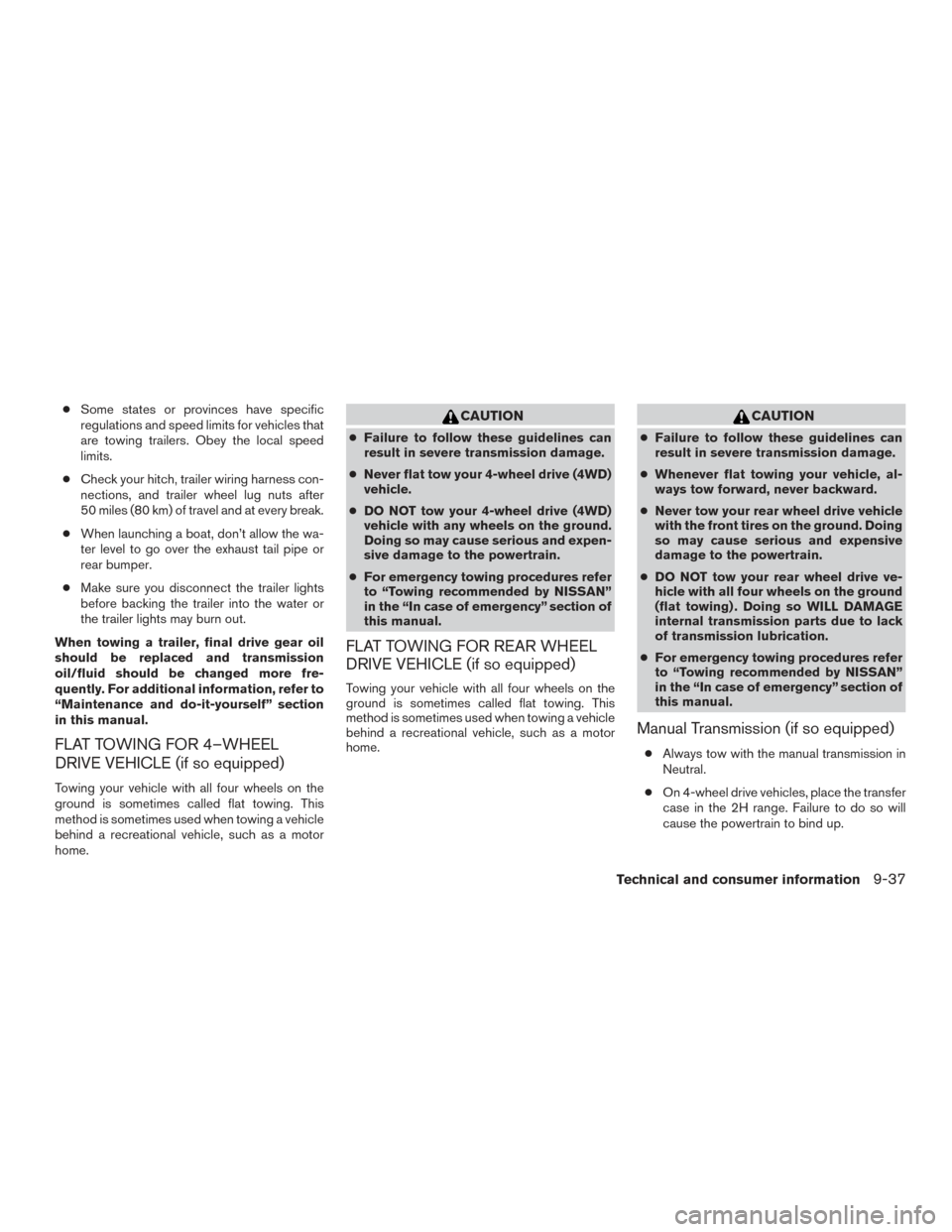
●Some states or provinces have specific
regulations and speed limits for vehicles that
are towing trailers. Obey the local speed
limits.
● Check your hitch, trailer wiring harness con-
nections, and trailer wheel lug nuts after
50 miles (80 km) of travel and at every break.
● When launching a boat, don’t allow the wa-
ter level to go over the exhaust tail pipe or
rear bumper.
● Make sure you disconnect the trailer lights
before backing the trailer into the water or
the trailer lights may burn out.
When towing a trailer, final drive gear oil
should be replaced and transmission
oil/fluid should be changed more fre-
quently. For additional information, refer to
“Maintenance and do-it-yourself” section
in this manual.
FLAT TOWING FOR 4–WHEEL
DRIVE VEHICLE (if so equipped)
Towing your vehicle with all four wheels on the
ground is sometimes called flat towing. This
method is sometimes used when towing a vehicle
behind a recreational vehicle, such as a motor
home.
CAUTION
● Failure to follow these guidelines can
result in severe transmission damage.
● Never flat tow your 4-wheel drive (4WD)
vehicle.
● DO NOT tow your 4-wheel drive (4WD)
vehicle with any wheels on the ground.
Doing so may cause serious and expen-
sive damage to the powertrain.
● For emergency towing procedures refer
to “Towing recommended by NISSAN”
in the “In case of emergency” section of
this manual.
FLAT TOWING FOR REAR WHEEL
DRIVE VEHICLE (if so equipped)
Towing your vehicle with all four wheels on the
ground is sometimes called flat towing. This
method is sometimes used when towing a vehicle
behind a recreational vehicle, such as a motor
home.
CAUTION
●Failure to follow these guidelines can
result in severe transmission damage.
● Whenever flat towing your vehicle, al-
ways tow forward, never backward.
● Never tow your rear wheel drive vehicle
with the front tires on the ground. Doing
so may cause serious and expensive
damage to the powertrain.
● DO NOT tow your rear wheel drive ve-
hicle with all four wheels on the ground
(flat towing) . Doing so WILL DAMAGE
internal transmission parts due to lack
of transmission lubrication.
● For emergency towing procedures refer
to “Towing recommended by NISSAN”
in the “In case of emergency” section of
this manual.
Manual Transmission (if so equipped)
● Always tow with the manual transmission in
Neutral.
● On 4-wheel drive vehicles, place the transfer
case in the 2H range. Failure to do so will
cause the powertrain to bind up.
Technical and consumer information9-37
Page 461 of 469
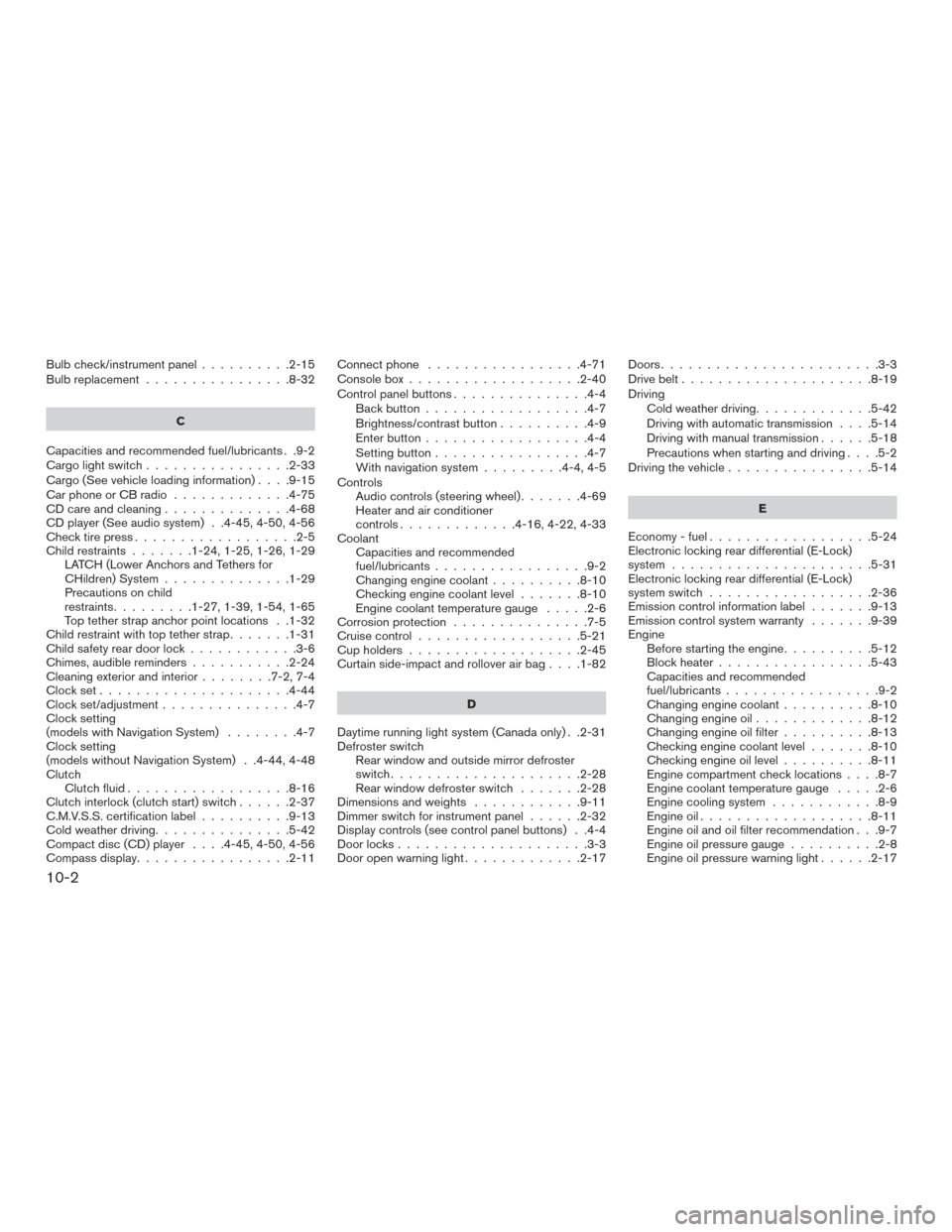
Bulb check/instrument panel..........2-15
Bulb replacement ................8-32
C
Capacities and recommended fuel/lubricants . .9-2
Cargolightswitch................2-33
Cargo(Seevehicleloadinginformation)....9-15
Car phone or CB radio .............4-75
CD care and cleaning ..............4-68
CD player (See audio system) . .4-45, 4-50, 4-56
Check tire press ..................2-5
Child restraints .......1-24,1-25,1-26,1-29
LATCH (Lower Anchors and Tethers for
CHildren) System ..............1-29
Precautions on child
restraints.........1-27,1-39,1-54,1-65
Top tether strap anchor point locations . .1-32
Child restraint with top tether strap .......1-31
Child safety rear door lock ............3-6
Chimes, audible reminders ...........2-24
Cleaningexteriorandinterior........7-2,7-4
Clockset.....................4-44
Clock set/adjustment ...............4-7
Clock setting
(models with Navigation System) ........4-7
Clock setting
(models without Navigation System) . .4-44, 4-48
Clutch Clutch fluid ..................8-16
Clutch interlock (clutch start) switch ......2-37
C.M.V.S.S. certification label ..........9-13
Cold weather driving ...............5-42
Compact disc (CD) player ....4-45,4-50,4-56
Compass display .................2-11 Connect phone
.................4-71
Console box ...................2-40
Control panel buttons ...............4-4
Back button ..................4-7
Brightness/contrast button ..........4-9
Enterbutton..................4-4
Setting button .................4-7
With navigation system .........4-4,4-5
Controls Audio controls (steering wheel) .......4-69
Heater and air conditioner
controls.............4-16,4-22,4-33
Coolant Capacities and recommended
fuel/lubricants .................9-2
Changingenginecoolant..........8-10
Checking engine coolant level .......8-10
Engine coolant temperature gauge .....2-6
Corrosion protection ...............7-5
Cruisecontrol..................5-21
Cupholders...................2-45
Curtainside-impactandrolloverairbag....1-82
D
Daytime running light system (Canada only) . .2-31
Defroster switch Rear window and outside mirror defroster
switch.....................2-28
Rear window defroster switch .......2-28
Dimensionsandweights ............9-11
Dimmer switch for instrument panel ......2-32
Display controls (see control panel buttons) . .4-4
Door locks .....................3-3
Door open warning light .............2-17 Doors
........................3-3
Drive belt .....................8-19
Driving Cold weather driving .............5-42
Driving with automatic transmission ....5-14
Driving with manual transmission ......5-18
Precautions when starting and driving ....5-2
Driving the vehicle ................5-14
E
Economy-fuel..................5-24
Electronic locking rear differential (E-Lock)
system ......................5-31
Electronic locking rear differential (E-Lock)
system switch ..................2-36
Emission control information label .......9-13
Emission control
system warranty .......9-39
Engine Before starting the engine ..........5-12
Blockheater.................5-43
Capacities and recommended
fuel/lubricants.................9-2
Changing engine coolant ..........8-10
Changingengineoil.............8-12
Changing engine oil filter ..........8-13
Checking engine coolant level .......8-10
Checking engine oil level ..........8-11
Engine compartment check locations ....8-7
Engine coolant temperature gauge .....2-6
Engine cooling system ............8-9
Engineoil...................8-11
Engine oil and oil filter recommendation . . .9-7
Engineoilpressuregauge..........2-8
Engine oil pressure warning light ......2-17
10-2
Page 465 of 469
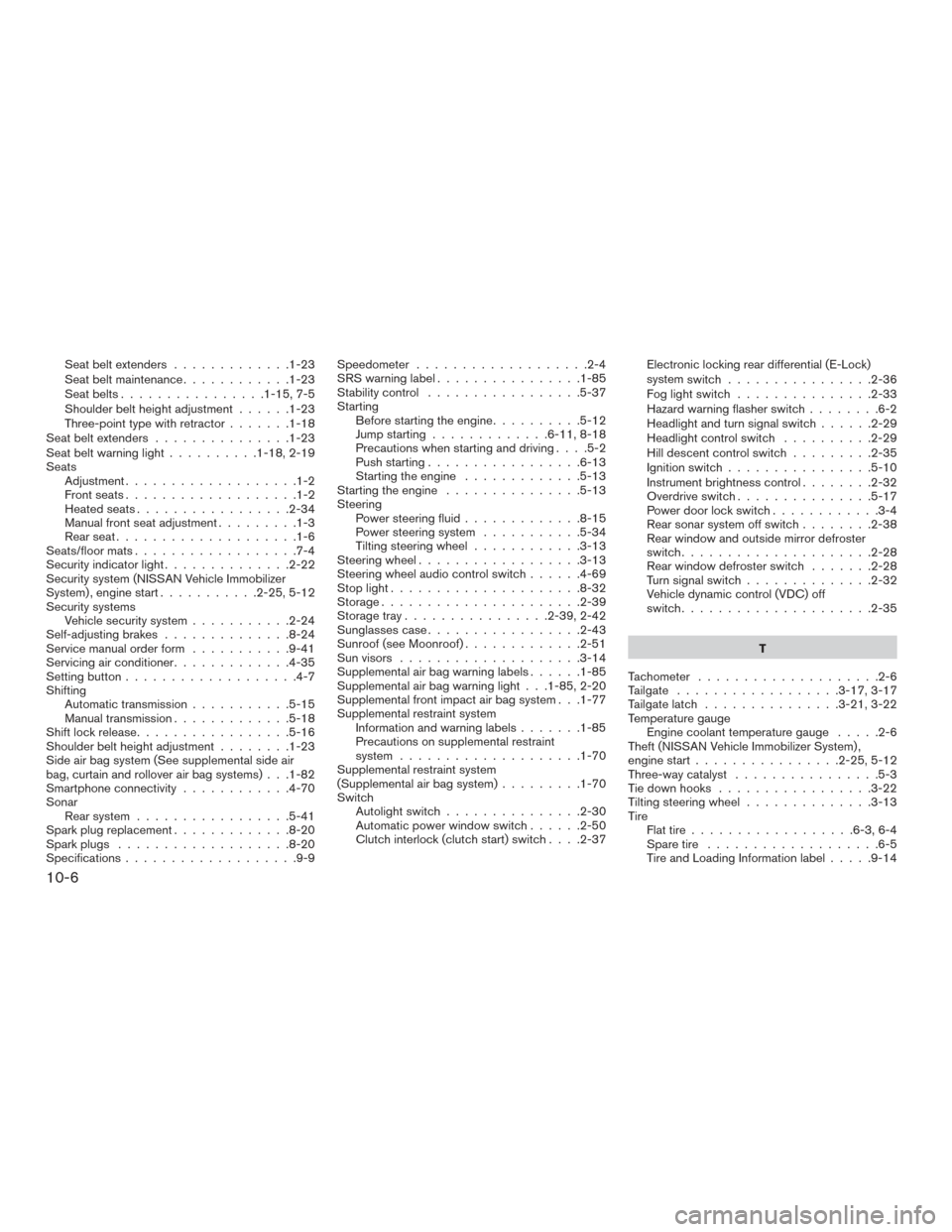
Seat belt extenders.............1-23
Seat belt maintenance ............1-23
Seat belts ................1-15,7-5
Shoulder belt height adjustment ......1-23
Three-point type with retractor .......1-18
Seat belt extenders ...............1-23
Seatbeltwarninglight..........1-18,2-19
Seats Adjustment ...................1-2
Frontseats...................1-2
Heatedseats.................2-34
Manual front seat adjustment .........1-3
Rear seat ....................1-6
Seats/floor mats ..................7-4
Security indicator light ..............2-22
Security system (NISSAN Vehicle Immobilizer
System) , engine start ...........2-25,5-12
Security systems Vehicle security system ...........2-24
Self-adjusting brakes ..............8-24
Service manual order form ...........9-41
Servicing air conditioner .............4-35
Setting button ...................4-7
Shifting Automatic transmission ...........5-15
Manual transmission .............5-18
Shift lock release .................5-16
Shoulder belt height adjustment ........1-23
Side air bag system (See supplemental side air
bag, curtain and rollover air bag systems) . . .1-82
Smartphone connectivity ............4-70
Sonar Rear system .................5-41
Spark plug replacement .............8-20
Spark plugs ...................8-20
Specifications ...................9-9 Speedometer
...................2-4
SRSwarninglabel................1-85
Stability control .................5-37
Starting Before starting the engine ..........5-12
Jump starting .............6-11,8-18
Precautions when starting and driving ....5-2
Push starting .................6-13
Starting the engine .............5-13
Starting the engine ...............5-13
Steering Power steering fluid .............8-15
Power steering system ...........5-34
Tilting steering wheel ............3-13
Steeringwheel..................3-13
Steering wheel audio control switch ......4-69
Stoplight.....................8-32
Storage......................2-39
Storage tray ................2-39,2-42
Sunglassescase.................2-43
Sunroof(seeMoonroof).............2-51
Sun visors ....................3-14
Supplemental air bag warning labels ......1-85
Supplemental air bag warning light . . .1-85, 2-20
Supplemental front impact air bag system . . .1-77
Supplemental restraint system Information and warning labels .......1-85
Precautions on supplemental restraint
system ....................1-70
Supplemental restraint system
(Supplemental air bag system) .........1-70
Switch Autolightswitch...............2-30
Automatic power window switch ......2-50
Clutch interlock (clutch start) switch ....2-37Electronic locking rear differential (E-Lock)
system
switch ................
2-36
Fog light switch ...............2-33
Hazard warning flasher switch ........6-2
Headlightandturnsignalswitch......2-29
Headlight control switch ..........2-29
Hilldescentcontrolswitch.........2-35
Ignition switch ................5-10
Instrument brightness control ........2-32
Overdrive switch ...............5-17
Power door lock switch ............3-4
Rear sonar system off switch ........2-38
Rear window and outside mirror defroster
switch .....................2-28
Rearwindowdefrosterswitch .......2-28
Turnsignalswitch..............2-32
Vehicle dynamic control (VDC) off
switch .....................2-35
T
Tachometer ....................2-6
Tailgate ..................3-17,3-17
Tailgate latch ...............3-21,3-22
Temperature gauge Engine coolant temperature gauge .....2-6
Theft (NISSAN Vehicle Immobilizer System) ,
engine start ................2-25,5-12
Three-way catalyst ................5-3
Tie down hooks .................3-22
Tilting steering wheel ..............3-13
Tire Flat tire ..................6-3,6-4
Spare tire ...................6-5
Tire and Loading Information label .....9-14
10-6
Page 466 of 469
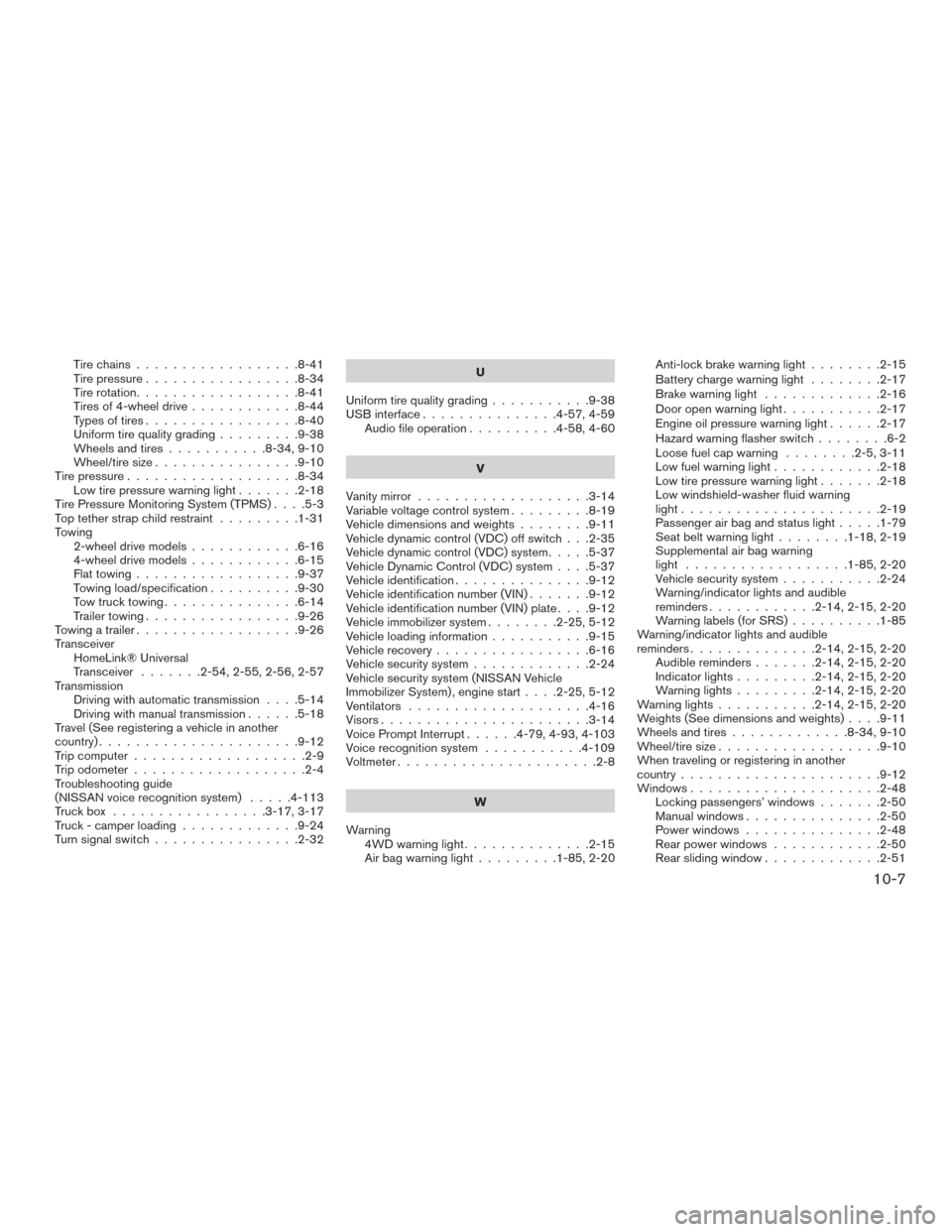
Tire chains..................8-41
Tirepressure.................8-34
Tire rotation..................8-41
Tires of 4-wheel drive ............8-44
Types of tires .................8-40
Uniform tire quality grading .........9-38
Wheels and tires ...........8-34,9-10
Wheel/tire size ................9-10
Tirepressure...................8-34 Low tire pressure warning light .......2-18
Tire Pressure Monitoring System (TPMS) ....5-3
Top tether strap child restraint .........1-31
Towing 2-wheel drive models ............6-16
4-wheel drive models ............6-15
Flattowing..................9-37
Towing load/specification ..........9-30
Towtrucktowing...............6-14
Trailer towing .................9-26
Towing a trailer ..................9-26
Transceiver HomeLink® Universal
Transceiver .......2-54,2-55,2-56,2-57
Transmission Driving with automatic transmission ....5-14
Driving with manual transmission ......5-18
Travel (See registering a vehicle in another
country) ......................9-12
Trip computer ...................2-9
Trip odometer ...................2-4
Troubleshooting guide
(NISSAN voice recognition system) .....4-113
Truckbox .................3-17,3-17
Truck - camper loading .............9-24
Turn signal switch ................2-32 U
Uniform tire quality grading ...........9-38
USB interface ...............4-57,4-59
Audio file operation ..........4-58,4-60
V
Vanity mirror ...................3-14
Variable voltage control system .........8-19
Vehicle dimensions and weights ........9-11
Vehicle dynamic control (VDC) off switch . . .2-35
Vehicle dynamic control (VDC) system .....5-37
Vehicle Dynamic Control (VDC) system ....5-37
Vehicle identification ...............9-12
Vehicle identification number (VIN) .......9-12
Vehicle identification number (VIN) plate ....9-12
Vehicle immobilizer system ........2-25,5-12
Vehicle loading information ...........9-15
Vehicle recovery .................6-16
Vehicle security system .............2-24
Vehicle security system (NISSAN Vehicle
Immobilizer System) , engine start ....2-25,5-12
Ventilators ....................4-16
Visors.......................3-14
Voice Prompt Interrupt ......4-79,4-93,4-103
Voice recognition system ...........4-109
Voltmeter......................2-8
W
Warning 4WD warning light ..............2-15
Airbagwarninglight.........1-85,2-20 Anti-lock brake warning light
........2-15
Battery charge warning light ........2-17
Brake warning light .............
2
-16
Door open warning light ...........2-17
Engine oil pressure warning light ......2-17
Hazard warning flasher switch ........6-2
Loose fuel cap warning ........2-5,3-11
Low fuel warning light ............2-18
Low tire pressure warning light .......2-18
Low windshield-washer fluid warning
light......................2-19
Passenger air bag and status light .....1-79
Seat belt warning light ........1-18,2-19
Supplemental air bag warning
light ..................1-85,2-20
Vehicle security system ...........2-24
Warning/indicator lights and audible
reminders ............2-14,2-15,2-20
Warning labels (for SRS) ..........1-85
Warning/indicator lights and audible
reminders..............2-14,2-15,2-20 Audiblereminders.......2-14,2-15,2-20
Indicatorlights.........2-14,2-15,2-20
Warning lights .........2-14,2-15,2-20
Warning lights ...........2-14,2-15,2-20
Weights (See dimensions and weights) ....9-11
Wheels and tires .............8-34,9-10
Wheel/tire size ..................9-10
When traveling or registering in another
country ......................9-12
Windows .....................2-48
Locking passengers’ windows .......2-50
Manual windows ...............2-50
Power windows ...............2-48
Rear power windows ............2-50
Rear sliding window .............2-51
10-7